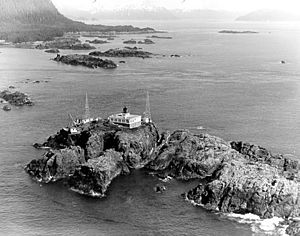Cape Spencer Light (Alaska) facts for kids
 |
|
| Cape Spencer Light | |
|
|
|
| Location | Cross Sound Glacier Bay National Park and Preserve Yakutat, Alaska |
|---|---|
| Coordinates | 58°11′56″N 136°38′25″W / 58.19891°N 136.64018°W |
| Year first constructed | 1925 |
| Automated | 1974 |
| Foundation | rock |
| Construction | reinforced concrete |
| Tower shape | flat-roofed house with short tower on top |
| Markings / pattern | art deco architecture white tower, black balcony and lantern |
| Height | 25 feet (7.6 m) |
| Focal height | 105 feet (32 m) |
| Original lens | Third order Fresnel lens |
| Range | 17 nautical miles (31 km; 20 mi) |
| Characteristic | Fl W 6s.abr> emergency light (Fl W 6s) of reduced intensity if main light is extinguished. |
| Admiralty number | G6508 |
| ARLHS number | ALK-004 |
| USCG number | 6-1070 |
The Cape Spencer Light is a cool lighthouse in Alaska, United States. It stands right at the entrance to Cross Sound and Icy Strait. This lighthouse is still working today, helping ships find their way. You can find it on a small island at the very southern tip of Glacier Bay National Park and Preserve.
Contents
History of the Cape Spencer Light
Building the Lighthouse
People started asking for a light at Cape Spencer way back in 1906. But it wasn't until 1912 that this rocky area got its first light. It was a simple, unmanned acetylene lantern.
Later, money was given to build a proper lighthouse. Construction began in May 1924. Workers built a strong concrete building. It was 51 feet by 62 feet. This building held the fog signal equipment and living spaces for the lighthouse keepers.
A 25-foot tall tower rose from the center of the roof. The Coast Guard removed the special Fresnel lens from Cape Spencer in 1974. That same year, the lighthouse became automated. This means machines took over the work.
Even today, this small lighthouse is very important for guiding ships. It sits on top of a 70-foot tall rock. The Coast Guard still visits it regularly.
Life at the Lighthouse
When the Cape Spencer Light was manned, four people worked there. The team included a commanding officer, an engineer, a seaman, and a fireman. Each person stayed on the island for a whole year. They usually didn't leave during this time.
Each crew member had their own bedroom. They worked four-hour shifts, keeping the light running. They also kept a constant radio watch.
Supplies came from a special ship called a buoy tender. This ship operated out of Ketchikan. The crew members pooled their daily allowance. They used this money to buy food from a store in Ketchikan. They usually ate very well, depending on who was cooking!
The lighthouse had a large food storage room in its basement. There were also freezers for frozen foods. Supplies arrived every two weeks, if the weather allowed. Sometimes, they went over three weeks without a resupply ship. This was tough, not just for food, but also because they missed mail and new movies. The station was about 100 miles (160 km) west of Juneau, so there wasn't much other entertainment.
Power and Access
The station got its power from three large Caterpillar Diesel Generators. One generator ran all the time to provide electricity. Many storage tanks around the station held fuel for these generators.
Below the main station, there was a boat house. There was also a building for a crane engine. This crane was powered by another Caterpillar engine. The island itself had no easy landing place. It had steep cliffs all around.
To get on or off the island, except by helicopter, they used the crane. A 16-foot fiberglass boat with an outboard engine was hooked to the crane. The men would climb into the boat. Then, the crane would swing them over the edge of the island. It would lower them 60 feet down to the water.
To get back on, they had to steer the boat under the hook at the base of the cliff. Once attached, the boat was lifted back up. This was a difficult task, especially in rough weather. Resupplying the station was done the same way. Cargo nets full of supplies were hoisted up onto the boathouse deck.
Getting to Juneau and Recreation
To travel to and from Juneau, the boat would take the men to Dicks Arm. This is a fjord about a mile from the island. It offered a calm place for float planes to land.
Dicks Arm was also a spot for the men to relax when they had time off. It was full of wildlife! There were black bears and grizzlies. Dall sheep could be seen on the higher slopes. The waters were rich with giant halibut, salmon (when in season), and huge king crabs. Seals often rested on the rocky islands near the light. Sometimes, groups of killer whales would swim between the lighthouse and the shore.
Even though Cape Spencer was considered "isolated duty," it wasn't the most isolated place the Coast Guard manned.
Important Milestones
In 1926, the Cape Spencer Lighthouse became the first lighthouse in Alaska to have radiobeacon facilities. This helped ships even more.
The lighthouse was added to the National Register of Historic Places in 1975. This means it's recognized as an important historical site.


